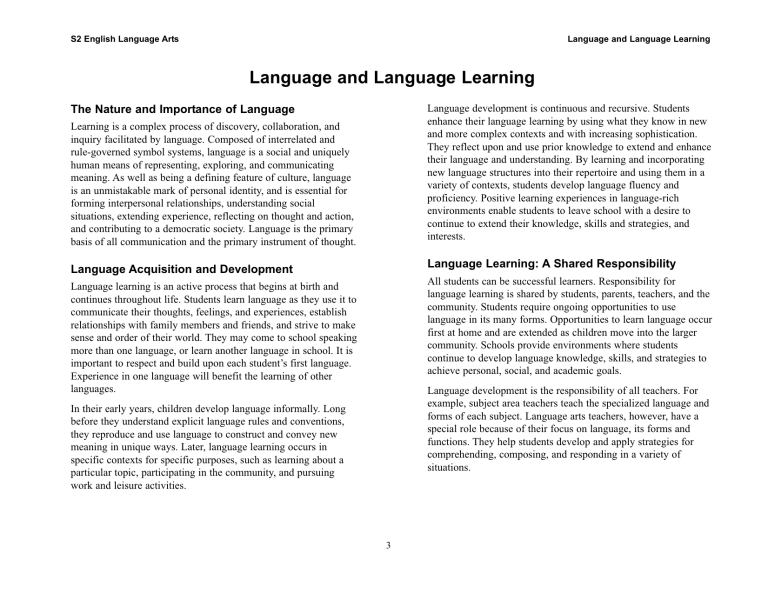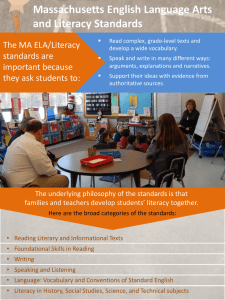
S2 English Language Arts Language and Language Learning Language and Language Learning Language development is continuous and recursive. Students enhance their language learning by using what they know in new and more complex contexts and with increasing sophistication. They reflect upon and use prior knowledge to extend and enhance their language and understanding. By learning and incorporating new language structures into their repertoire and using them in a variety of contexts, students develop language fluency and proficiency. Positive learning experiences in language-rich environments enable students to leave school with a desire to continue to extend their knowledge, skills and strategies, and interests. The Nature and Importance of Language Learning is a complex process of discovery, collaboration, and inquiry facilitated by language. Composed of interrelated and rule-governed symbol systems, language is a social and uniquely human means of representing, exploring, and communicating meaning. As well as being a defining feature of culture, language is an unmistakable mark of personal identity, and is essential for forming interpersonal relationships, understanding social situations, extending experience, reflecting on thought and action, and contributing to a democratic society. Language is the primary basis of all communication and the primary instrument of thought. Language Learning: A Shared Responsibility Language Acquisition and Development All students can be successful learners. Responsibility for language learning is shared by students, parents, teachers, and the community. Students require ongoing opportunities to use language in its many forms. Opportunities to learn language occur first at home and are extended as children move into the larger community. Schools provide environments where students continue to develop language knowledge, skills, and strategies to achieve personal, social, and academic goals. Language learning is an active process that begins at birth and continues throughout life. Students learn language as they use it to communicate their thoughts, feelings, and experiences, establish relationships with family members and friends, and strive to make sense and order of their world. They may come to school speaking more than one language, or learn another language in school. It is important to respect and build upon each student’s first language. Experience in one language will benefit the learning of other languages. Language development is the responsibility of all teachers. For example, subject area teachers teach the specialized language and forms of each subject. Language arts teachers, however, have a special role because of their focus on language, its forms and functions. They help students develop and apply strategies for comprehending, composing, and responding in a variety of situations. In their early years, children develop language informally. Long before they understand explicit language rules and conventions, they reproduce and use language to construct and convey new meaning in unique ways. Later, language learning occurs in specific contexts for specific purposes, such as learning about a particular topic, participating in the community, and pursuing work and leisure activities. 3 Language and Language Learning S2 English Language Arts Thinking and Learning Through Language Thinking, learning, and language are interrelated. From Kindergarten to Senior 4, students use language to make sense of and bring order to their world. They use language to examine new experiences and knowledge in relation to their prior knowledge, experiences, and beliefs. They make connections, anticipate possibilities, reflect upon ideas, and determine courses of action. Students’ language development is integral to their success in every area in school. Language enables students to play an active role in various communities of learners within and beyond the classroom. As students speak, write, and represent, they also listen to, read, and view the ideas and experiences of others. Critical and creative thinking and learning through language occur when students reflect, speculate, create, analyze, and synthesize. In addition, language enables students to develop metacognition; that is, it enables them to reflect upon and control their own thinking and learning processes. Language helps students develop an awareness of the skills and strategies they need to complete learning tasks successfully and to communicate about themselves as learners. • acknowledges the important and unique nature of early literacy, a concept recognizing that children begin to develop literacy long before they enter school and that their experiences continue to influence language learning • recognizes that each learner constructs knowledge actively based on his or her own prior knowledge and experiences • encourages interactive processes that facilitate the social construction of knowledge • acknowledges the importance of students’ affective (emotional) response in learning situations, and focuses on fostering engagement and connecting learning to students’ experiences and interests • encourages strategic thinking and promotes the development, for each student, of a repertoire of strategies for use in problem solving and literacy tasks • encourages risk taking and independence as steps in the language learning process, and promotes the gradual release of responsibility for learning from teacher to student • promotes the importance of inquiry and critical thinking in the development of reflective learners • emphasizes that metacognition (awareness of one’s own thinking and learning) enables learners to plan, monitor progress, and evaluate personal learning • promotes active, resource-based learning that draws on a broad range of human, technological, and other resources from within and beyond the school • emphasizes the impact of technological advances on language teaching and learning • recognizes the impact of media on students in extending learning within and beyond the traditional boundaries of school Recent Developments in Understanding Language Learning The ELA Framework reflects an expanded understanding, based on recent research, of how students develop language and literacy skills. The ELA Framework • incorporates viewing and representing as language arts, in addition to listening, speaking, reading, and writing • reflects and stresses the integrated nature of the six language arts 4 S2 English Language Arts Language and Language Learning The English Language Arts Listening and Speaking The study of English language arts enables each student to understand and appreciate language, and to use it competently and confidently in a variety of situations for communication, personal satisfaction, and learning. Students become competent and confident users of all six language arts through many opportunities to listen, speak, read, write, view, and represent in a variety of combinations and through a wide range of relevant texts. Oral language is the foundation of literacy. Through listening and speaking, people communicate thoughts, feelings, experiences, information, and opinions, and learn to understand themselves and others. Oral language carries a community’s stories, values, beliefs, and traditions. Listening and speaking enable students to explore ideas and concepts as well as to understand and organize their experiences and knowledge. They use oral language to learn, solve problems, and reach goals. To become discerning, lifelong learners, students at all grades need to develop fluency and confidence in their oral language abilities. They benefit from many opportunities to listen and speak both informally and formally for a variety of purposes. Instruction in all six language arts equips students for effective participation in a technological society in which information, communication, and entertainment are increasingly conveyed in language forms other than print. In the ELA Framework, the terms “text” and “reading” are used inclusively: • Text refers to all language forms that can be discussed, studied, and analyzed. This includes: print texts such as fiction and non-fiction books, essays, and news reports; oral texts such as storytelling, dialogues, speeches, and conversations; and visual texts such as pictures, diagrams, tableaux, mime, and nonverbal communication. • Reading refers to constructing meaning from texts of any kind. Reading and Writing Reading and writing are powerful means of communicating and learning. They enable students to extend their knowledge and use of language, increase their understanding of themselves and others, and experience enjoyment and personal satisfaction. Reading provides students with a means of accessing the ideas, views, and experiences of others. By using effective reading skills and strategies, students construct meaning and develop thoughtful and critical interpretations of a variety of texts such as both short and book-length fiction and non-fiction. Writing enables students to explore, shape, and clarify their thoughts, and to communicate them to others. By using effective writing strategies, students discover and refine ideas and compose and revise with increasing confidence and skill. Texts are affected and influenced by how they are transmitted, whether by computer, television, radio, or book. Media texts and electronic texts such as videos, films, cartoons, and electronically distributed magazines frequently include oral, written, and visual components simultaneously. The language arts are clearly interrelated and interdependent: students need knowledge, skills, and strategies in all six language arts to compose, comprehend, and respond to texts. The student learning outcomes presented in the ELA Framework integrate the six language arts. In selecting learning resources and in planning instruction and assessment, teachers strive to achieve variety and balance in the use of the six language arts. Viewing and Representing Viewing and representing are integral parts of contemporary life. They allow students to understand the ways in which images and language may be used to convey ideas, values, and beliefs. 5 Language and Language Learning S2 English Language Arts Viewing is an active process of attending to and comprehending visual media such as television, advertising images, films, diagrams, symbols, photographs, videos, drama, drawings, sculpture, and paintings. Viewing enables students to acquire information and to appreciate the ideas and experiences of others. Many of the comprehension processes involved in reading (such as previewing, predicting, and making inferences) are also used in viewing. Representing enables students to communicate information and ideas through a variety of media, video presentations, posters, diagrams, charts, symbols, visual art, drama, mime, and models. 6




